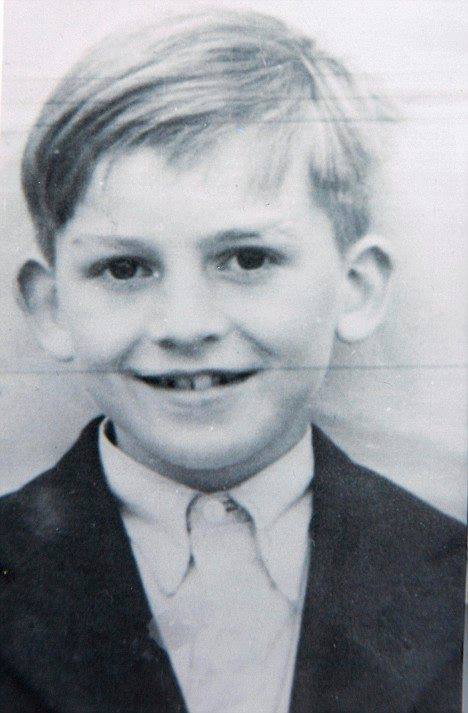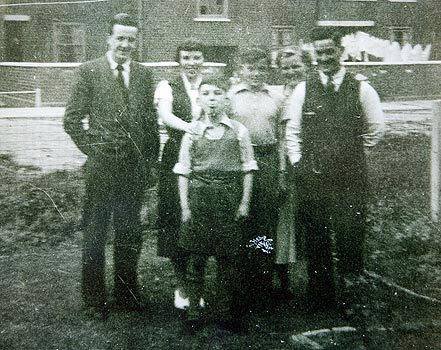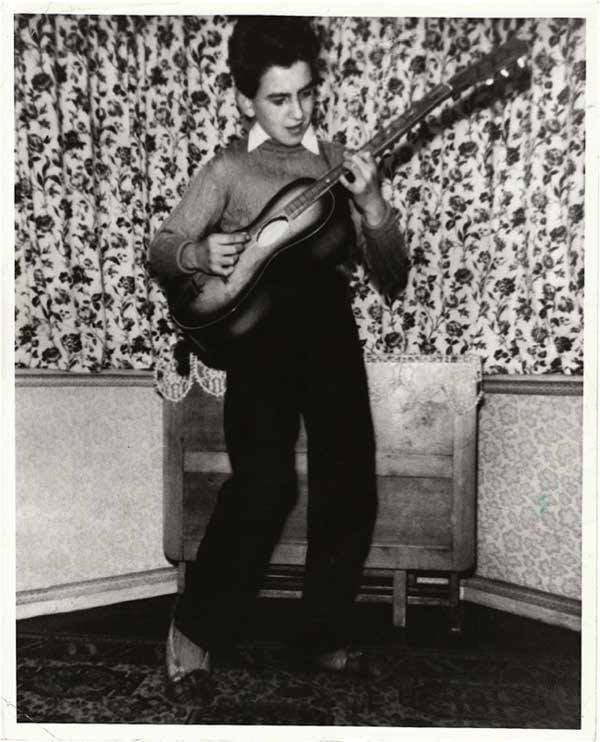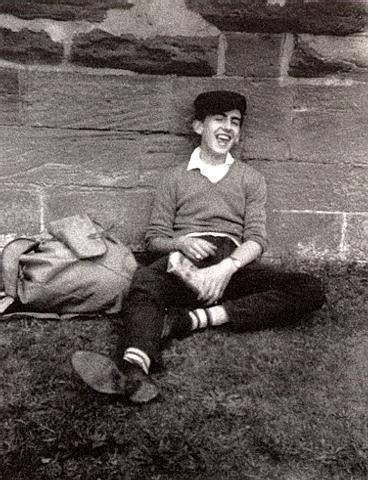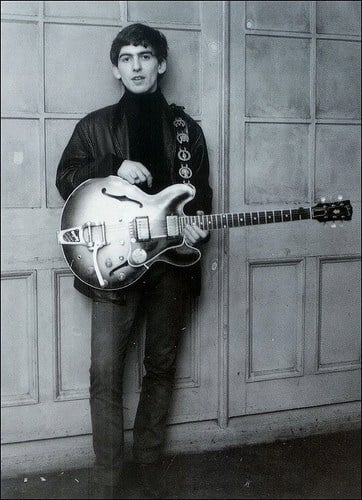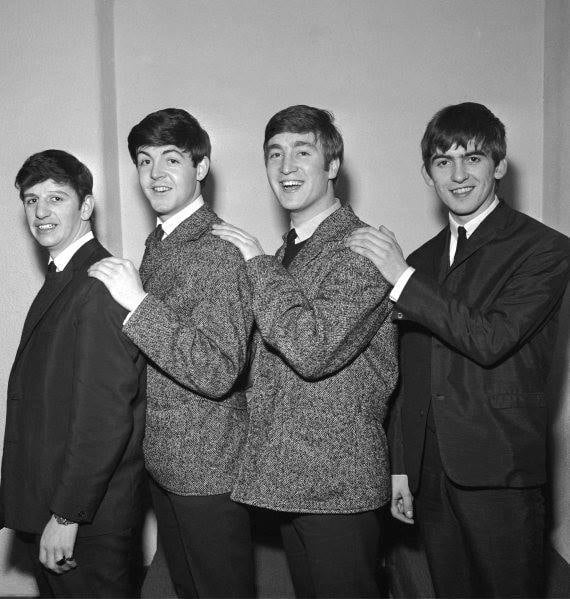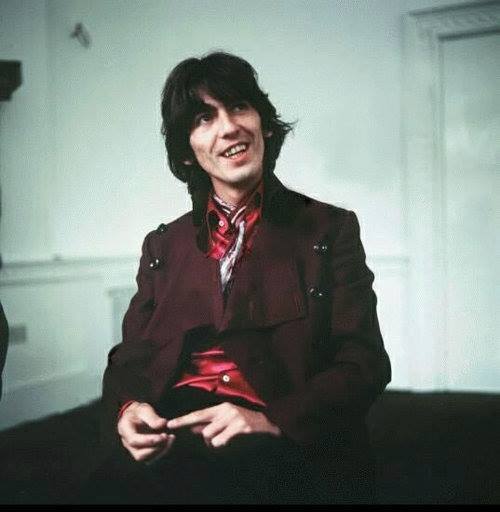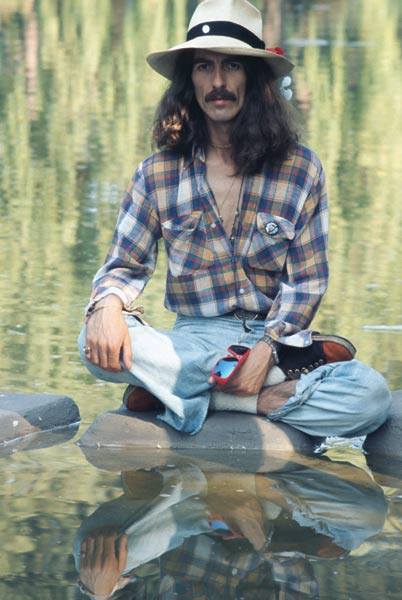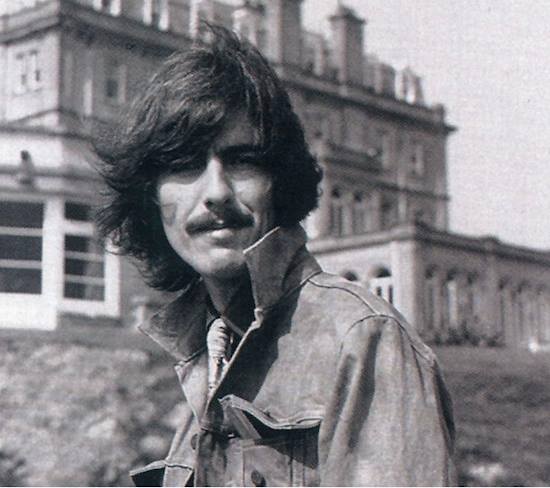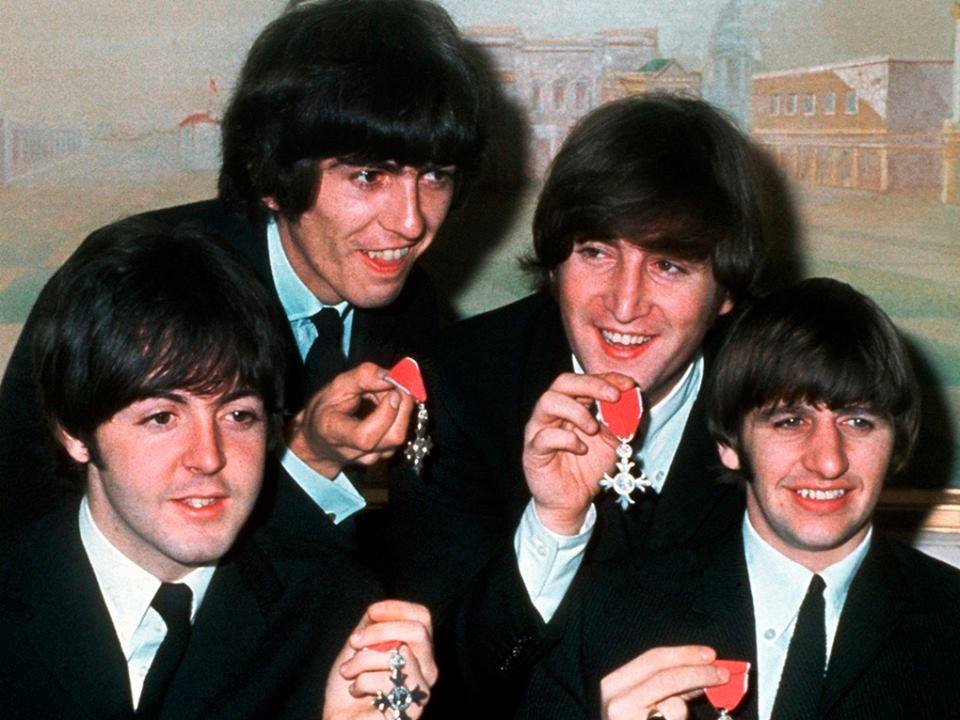November 29, 2001 George Harrison died from metastatic non-small cell lung cancer
He was cremated at Hollywood Forever Cemetery, and his funeral was held at the Self-Realization Fellowship Lake Shrine in the Pacific Palasades, California. His ashes were scattered in the Ganges and Yamuna Rivers near Varanasi, India by his close family in a private ceremony according to Hindu tradition.. He left almost £100 million in his will.Harrison was first diagnosed with throat cancer in 1997 and treated with radiotherapy, which was thought at the time to be successful. He publicly blamed years of smoking for the illness. In May 2001, it was revealed that he had undergone an operation to remove a cancerous growth from one of his lungs, and in July, it was reported that he was being treated for a brain tumor at a clinic in Switzerland where Ringo Starr visited him, but had to cut his stay short to travel to Boston, where his daughter was undergoing emergency brain surgery, prompting Harrison to quip: “Do you want me to come with you?” In November 2001, he began radiotherapy at Staten Island University Hospital in New York City for lung cancer that had spread to his brain. When the news was publicized, Harrison bemoaned his physician’s breach of privacy, and his estate later claimed damages. On November 12th, the three living former Beatles met for the last time at Harrison’s hotel in New York for lunch.Harrison was born to Harold and Louise French Harrison, who had roots in Ireland. He had three siblings: Louise, Harry and Peter, all of whom were older than George. In 1950 the family moved to 25 Upton Green in Speke. George went to school at Dovedale Road, where he passed his 11 Plus and gained a place at the Liverpool Institute for Boys, a local grammar school.He attended the Institute between 1954 and 1959. Not an especially gifted child academically, Harrison struggled as a student and left without any qualifications. He had trouble relating to his teachers, and insisted on wearing tight jeans and long hair, much to his parents consternation.In 1959 Harrison formed a skiffle group called The Rebels with his brother Peter and his friend Arthur Kelly. Harrison’s mother bought him a guitar for £3, and the group’s debut gig at the British Legion club in Speke earned them 10 shillings.Harrison considered becoming an apprentice engineer after leaving school, but music dominated his passions and he performed with a number of fledgling groups in Liverpool. In 1958 he met the Quarrymen, whose ranks included Paul McCartney, a friend of Harrison’s from the Institute.Although Harrison was considered too young to join the group, he did fill in when their regular guitarist Eric Griffiths was unavailable. Eventually he was accepted as a full member, despite the reservations of the Quarrymen founder and leader, John Lennon.Lennon recalled: “Paul introduced me to George and I had to make the decision whether to let George in. I listened to George play and said, ‘Play Raunchy’ [a 1958 hit for saxophonist Bill Justis]. Then I said, ‘OK, you can come in.’ I couldn’t be bothered with him when he first came around. He used to follow me around like a bloody kid, hanging around all the time. He was a kid who played guitar and he was a friend of Paul’s which made it easier. It took me years to come around to him, to start considering him as an equal.”Harrison’s influences ran to rockabilly heroes like Carl Perkins and British skiffle legend Lonnie Donegan. His retooled rockabilly licks were key to the band’s early sound, while his sharp, innovative lead guitar was essential to later recordings.The Quarry Men became Johnny and the Moondogs, and later the Silver Beetles. Their first trip to Hamburg in August 1960 took place while Harrison was just 17, and the Reeperbahn, the red light district where they played, proved an educative experience: “Everybody around the district were homosexuals, transvestites, pimps and hookers and I was in the middle of that, aged 17,” he said.The first trip ended in Harrison’s deportation for working under-age. When they returned in March 1961 The Beatles had become more assured as performers, and in June cut their first single, “My Bonnie, as the backing band for Tony Sheridan. For this they were paid 300 marks with no royalties.At the band’s first recording session for EMI, producer George Martin tried to ease the band’s nerves by saying, “Let me know if there’s anything you don’t like.” “Well, for a start,” replied Harrison, “I don’t like your tie.” This led to a succession of jokes being cracked in the studio, which endeared the band to the EMI staff.As Beatlemania took hold, John Lennon and Paul McCartney dominated the group’s output: “There was an embarrassing period when George’s songs weren’t that good and nobody wanted to say anything,” John Lennon later said. “He just wasn’t in the same league for a long time – that’s not putting him down, he just hadn’t had the practice as a writer that we’d had.”Known as “the quiet one” of The Beatles, Harrison’s first published composition was “Don’t Bother Me” which he wrote while ill in a hotel room in Bournemouth in the summer of 1963. It appeared on their second album “With The Beatles.” Harrison was later dismissive of “Don’t Bother Me” saying “It was a fairly crappy song. I forgot all about it completely once it was on the album… At least it showed me that all I needed to do was keep on writing and then maybe eventually I would write something good.”During The Beatles’ first US tour, Rickenbacker gave Harrison a 12-string electric guitar – a 360/12 model. The instrument became characteristic of The Beatles early to mid 1960s sound, particularly on the “A Hard Day’s Night” album, and influenced many other bands including The Byrds.Harrison sang at least one song on all The Beatles’ albums, though as a songwriter he remained in the shadow of Lennon and McCartney. Following “Don’t Bother Me”, his next self-penned songs were “I Need You” and “You Like Me too Much” on the 1965 “Help!” album.George Harrison’s interest in Indian music was awoken by a scene in the “Help!” film. While filming, a Hindu devotee gave each member of The Beatles a signed copy of his book, “The Complete Illustrated Book of Yoga” which led to a fascination with many aspects of Eastern religion, culture and philosophy.The Byrds’ David Crosby introduced George to the music of Ravi Shankar during a US tour in 1965, and he became fascinated by the sitar. He became friends with Shankar, who became his sitar teacher. Harrison became the first Western musician to play a sitar on a pop record when “Norwegian Wood (This Bird Has Flown)”, on the 1965 album “Rubber Soul.”As George remembered: “After ‘Norwegian Wood’ I met Ravi Shankar in London for dinner. He offered to give me instruction in the basics of the sitar. It was the first time I had ever really learnt music with a bit of discipline. Then I listened to Indian music for the next two years and hardly touched the guitar except for recording.”For 1966’s “Revolver” he recorded “Love You To,” which featured no Western instrumentation. Following its recording, he went on a pilgrimage to India with his wife Pattie. The couple had met during the filming of “A Hard Day’s Night” and married on January 21, 1966.Pattie introduced George to transcendental meditation, and in 1968 they, along with the rest of The Beatles and their partners, traveled to India to study with Maharishi Mahesh Yogi. Although the band later fell out with the Maharishi, Harrison continued his interest in Eastern philosophy. He embraced the Hare Krishna tradition, and in 1969 produced the single “Hare Krishna Mantra” by the Radha Krishna Temple. Harrison also became a vegetarian in the late 1960s and became an assured songwriter. Following “Taxman,” the bitter social commentary which opened “Revolver,” he wrote “Within You Without You”, which mainly featured Indian musicians and instruments, for “Sgt, Pepper’s Lonely Hearts Club Band”. He also contributed an unprecedented four songs to 1968’s “The Beatles” (aka “The White Album”): “While My Guitar Gently Weeps”, “Piggies”, “Savoy Truffle” and “Long, Long, Long”. But Harrison’s high point as a songwriter in The Beatles came with “Abbey Road” in 1969. He wrote “Here Comes The Sun” at Eric Clapton’s house, while ducking out of duties at Apple.He recalled the occasion: “‘Here Comes The Sun’ was written at the time when Apple was getting like school, where we had to go and be businessmen: ‘Sign this’ and ‘sign that’. Anyway, it seems as if winter in England goes on forever, by the time spring comes you really deserve it. So one day I decided I was going to sag off Apple and I went over to Eric Clapton’s house. The relief of not having to go see all those dopey accountants was wonderful, and I walked around the garden with one of Eric’s acoustic guitars and wrote ‘Here Comes The Sun’.”Better still was “Something, which was released as a single in October 1969. John Lennon called it “the best track on the album,” and McCartney said “I think it’s the best he’s written.” Harrison was given an Ivor Novello award for the song, which was covered by artists including Elvis Presley, The O’Jays and Ray Charles. Even Frank Sinatra called it “the greatest love song ever written.”Harrison’s music projects during the final years of the Beatles included producing Apple Records artists Doris Troy, Jackie Lomax and Billy Preston. Throughout his solo career, he benefited from the inclusion of guest musicians on his albums, and he made efforts to reciprocate the favors by participating in their recordings. He was featured as a guitarist on tracks by Dave Mason, Nicky Hopkins, Alvin Lee, Ronnie Wood, Billy Preston and Tom Scott. Harrison co-wrote songs and music with Dylan, Clapton, Preston, Doris Troy, David Bromberg, Gary Wright, Wood, Jeff Lynne, and Tom Petty, among others.Harrison described The Beatles’ acrimonious break-up as “just a relief. We should have done it years ago.” He used the stockpile of songs written while in the group as the basis for “All Things Must Pass”, the first triple album by a rock artist. It topped the charts, as did the singles “My Sweet Lord” and “Isn’t It A Pity.”He organized the first major charity rock concert. “The Concert for Bangladesh” took place on August 1, 1971, and featured Ravi Shankar, Bob Dylan, Eric Clapton, Leon Russell, Badfinger, Billy Preston and Ringo Starr. Proceeds from the concert, soundtrack album and documentary film were earmarked for the United Nations Children’s Fund for Relief to Refugee Children of Bangladesh. It became a model for rock-benefit projects from Live Aid to The Concert for New York City. Over time, Harrison’s donations to UNICEF for Bangladesh from concert, film and album proceeds totaled more than $13 million.In addition to his continuing solo career, Harrison worked with Ringo Starr on his hits “It Don’t Come Easy” and “Photograph”, and played on John Lennon’s “Imagine” album. He also performed with Badfinger, Harry Nilsson and Billy Preston.But not everything about post-Beatles life went smoothly for Harrison. In 1974, his marriage to Pattie ended when she left him for Eric Clapton. His studio work struggled, too. “Living in the Material World” (1973), “Extra Texture” (1975) and “Thirty-Three & 1/3” (1976) all failed to meet sales expectations. But also in 1974 he opened the offices of his Dark Horse label. There he met Olivia Trinidad Arias, who he formed a relationship. The couple married in September 1978, one month after the birth of their son Dhani.In 1980 Harrison published his autobiography, “I Me Mine”, written with The Beatles’ former publicist Derek Taylor. The book said little new about The Beatles, focusing instead mainly on his non-musical interests, though it did include lyrics and photographs from the 1960s.Harrison was deeply troubled by the death of John Lennon in December 1980. He changed the lyrics of a song intended for Starr, creating a tribute song for Lennon. “All Those Years Ago”, featured all three surviving members of The Beatles, and was a hit single when released in May 1981.His critically-acclaimed “Cloud Nine” album, released in 1987, was a welcome hit after a few years in the musical wilderness. It featured the hit single “Got My Mind Set On You,” a cover version of James Ray’s 1962 song, and “When We Was Fab,” a song with many musical and lyrical references about The Beatles, co-written with ELO’s Jeff Lynne.The video to “When We Was Fab” featured Ringo Starr, plus a man in a walrus costume playing a left-handed bass. Guest appearances were also made by Elton John, Derek Taylor and Neil Aspinall. The cover of the single incorporated Klaus Voormann’s drawing of Harrison from the cover of “Revolver,” along with an updated picture of the older musician.In 1988 Harrison co-formed the Traveling Wilburys with Roy Orbison, Bob Dylan, Jeff Lynne and Tom Petty, to record a b-side called “Handle With Care” for a Harrison single. Encouraged by the record company, they recorded their debut album in two weeks, and its success led to a second LP.In addition to music, Harrison was also actively involved in his production company Handmade Films. He gave financial backing to the Monty Python film “The Life Of Brian” and appeared in one scene. Handmade also produced “Mona Lisa,” “Time Bandits,” “Shanghai Surprise” and “Withnail And I”; 27 in total. Harrison also appeared as a reporter in the Beatles parody film “The Rutles” and appeared in an episode of “The Simpsons.”Harrison reunited with Paul McCartney and Ringo Starr between 1994 and 1996 for “The Beatles Anthology” project. In addition to the book and documentary series, he performed on “Free As A Bird” and “Real Love” with the surviving Beatles.Harrison was initially diagnosed with throat cancer in August 1997, and underwent radiotherapy and surgery. Throughout the late 1990s he battled the disease, having tumors removed from his throat and lung.On the night of December 30, 1999 an mentally unstable intruder named Michael Abram broke into the Harrison’ home at Friar Park in Henley-on-Thames. He stabbed George several times, puncturing his lung. George and Olivia fought off Abram and restrained him until the police arrived. The assailant, who believed he was on a “mission from God” to kill Harrison, was acquitted of attempted murder on the grounds of insanity.Harrison was deeply traumatized by the event, although he did joke that the man was “definitely not auditioning for the Traveling Wilburys.” He subsequently largely withdrew from public life, and his final recording session was for a new song “Horse To The Water,” released in November 2001 on Jools Holland’s album “Small World, Big Band.”Harrison’s cancer recurred in the same year, and was found to have spread to other organs. Although treated aggressively, it was diagnosed as terminal. He arranged to spend his final months with family and close friends, and worked on songs from an album with his son Dhani, released posthumously in 2002 as “Brainwashed.”.Exactly a year after his demise, Eric Clapton and Olivia Harrison organized “The Concert for George,” a tribute performance that involved McCartney and Starr, as well as concert supervisor Clapton, Jeff Lynne, Tom Petty and Ravi Shankar. Proceeds went to Harrison’s Material World Charitable Foundation, which he’d founded back in 1973.During a CNN interview with Larry King in 2007, Paul McCartney described visiting Harrison on his death bed and sitting silently with him, stroking his hand to comfort him.At the 2015 Grammy Awards, Harrison was posthumously honored with the Lifetime Achievement Grammy, presented by Tom Petty who said: “He never wanted to be the star of anything. But, that’s the place fate left him. He thought he was best as a team player. But we all know there was just too much great music in him to be contained by modesty… George truly was the peace and love guy. It wasn’t a fad for him. He walked the walk. He dropped some beautiful wisdom on us without preaching, and always keeping a sense of humor, he was forever mindful that we are all so, so human.”In September, 2015, StormFront Comics released a new biography about the famed Beatle entitled “George Harrison: An Animated Tale.”
SOURCES
www.thebeatles.com/http://www.georgeharrison.com/
http://www.beatlesstory.com/http://www.beatlesagain.com/
http://www.iamthebeatles.com/http://www.imdb.com/name/nm0365600/
http://www.nndb.com/people/661/000024589/
http://www.biography.com/people/groups/the-beatles
http://www.songfacts.com/facts-george_harrison.php
http://www.npr.org/artists/15774029/george-harrisonhttp://www.biography.com/people/george-harrison-9206804http://www.beatlesnews.com/news/george-harrison.htmlhttp://www.encyclopedia.com/topic/George_Harrison.aspx
https://rockhall.com/inductees/george-harrison/bio/
http://www.beatlesbible.com/people/george-harrison/
https://www.allmusic.com/artist/george-harrison-mn0000209142/biography
https://www.allmusic.com/artist/the-beatles-mn0000754032/biographyhttps://en.wikipedia.org/wiki/The_Beatles
https://en.wikipedia.org/wiki/George_Harrisonhttps://www.facebook.com/georgeharrison
https://www.facebook.com/thebeatleshttps://twitter.com/georgeharrison
